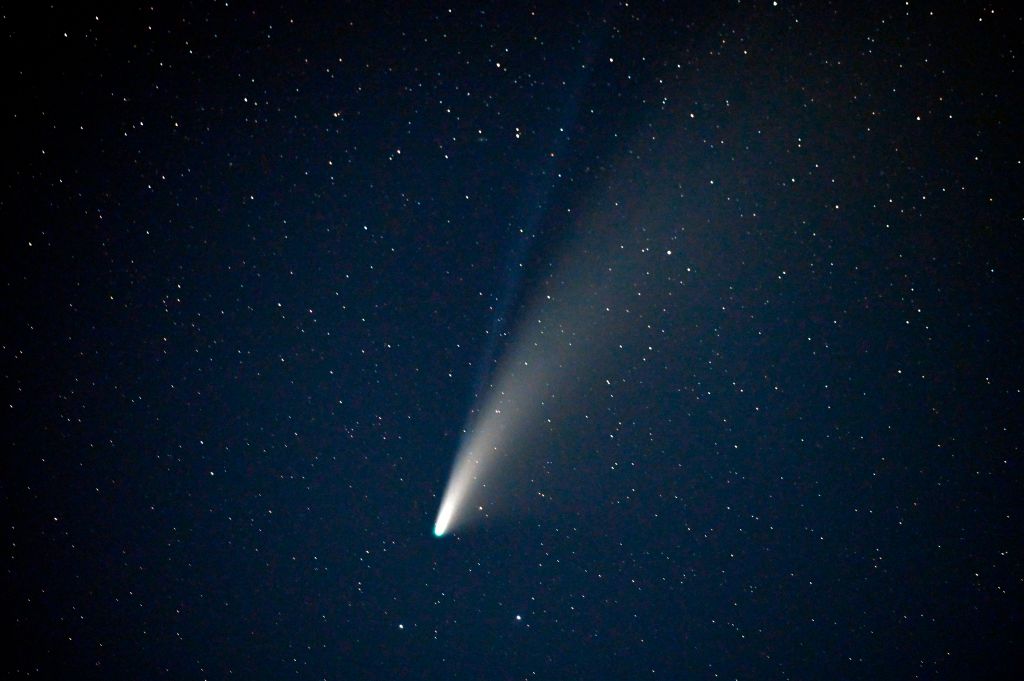
You wouldn’t want much to do with Chile’s Atacama Desert today. Officially designated the driest place in the world, it has an average annual rainfall of just 15 mm (0.6 in.). Some parts of the 103,000 sq. km (40,500 sq. mi) expanse get no rain at all. But 12,000 years ago, at the end of the Pleistocene era, things were different. Megafauna like sloths and early horses roamed what was then a grassland, and humans had begun to settle the area.
Shifting trade winds and ocean currents eventually shut off the rain, but even before those terrestrial forces transformed the Atacama, a decidedly extraterrestrial one did too: at that same 12,000 year point, a great comet exploded over the region, turning a 75 km (45 m) stretch of land partly to green and black glass. At least that’s the conclusion of a new study published Nov. 2 in Geology, and if the researchers are right, there could be more such glassy scarring from more such comet hits elsewhere on Earth.
The glassy corridor just north of the Andes Mountains, discovered in 2012, was originally attributed to intense wildfires that burned away scrub and grasses and melted the underlying soil. Carbon dating fixed the time of the glass’ formation, but Peter Schultz, a planetary scientist at Brown University and lead author of the new paper, was not so sure about the rest of the scenario. The extent of the glass was greater than what wildfires would likely cause, and traces of ancient organic material—grasses and other vegetation that would have had to feed the flames—were not present in sufficient quantities to support the wildfire model.
To investigate the mystery further, Schultz and his colleagues collected 300 samples of glass from multiple sites separated by 30 km and subjected them to laboratory analysis. Straightaway, nothing they saw in their photomicrographs supported the wildfire theory.
For starters, the samples contained metallic minerals known as zircons that had decomposed to an oxide form known as baddeyelite. That can happen under the influence of heat—but only heat that exceeds 1,700° C (3,000° F), far hotter than what a grass fire could cause. What’s more, even if the fires had been hot enough to have melted the soil, the glass that resulted would have been relatively smooth and evenly distributed. This glass, however, showed signs of shearing, folding, tearing and rolling, consistent with the kind of airbursts and tornado-force winds associated with a comet explosion that would have flung the molten material great distances.
“In other words,” said Schultz in an email to TIME, “there was a dynamic force that formed them.”
Much more telling—and much more conclusive—were other materials found in the glass samples, especially the iron sulfides known as cubanite and troilite, and a phosphate mineral known as chlorapatite. Those and other minerals embedded in the glass are scarce on Earth but very common in asteroids and comets. In 2004, NASA’s Stardust spacecraft flew by Comet Wild-2, collected samples of its dust and mineral grains and returned them to Earth in 2006. Those samples, Schultz and his colleagues found, closely match what they found in the Atacama glass.
“To have the same mineralogy we saw in the Stardust samples entrained in these glasses is really powerful evidence that what we’re seeing is a cometary airburst,” said planetary scientist and study co-author Scott Harris, of the Fernbank Science Center, in a statement that accompanied the research.
The event’s impact on life in the region is uncertain. However, the formation of the glass coincides closely with the disappearance of fauna from the early Atacama, at least suggesting a local extinction event similar to—if much smaller than—the massive asteroid collision that wiped out the dinosaurs 65 million years ago.
“While a direct causal link is not claimed,” the authors wrote, “the timing is intriguing.”
The study also raises questions about other, similarly glassy expanses in Chile—one 250 km from the site studied in the paper and one 2,600 km distant—which may also have had cometary origins. Indeed, Schultz believes, there could be an untold number of comet scars around the world—even if they’re not easy to find.
“There should be more examples,” he told TIME. “The difficulty is that such glasses can be easily destroyed with time. In addition, we found that only certain soils—fine dust—will form the glasses.”
Regardless of how many times the Earth has been struck in the past, the new study holds warnings for the future, too. Twelve thousand years ago is nothing in cosmic time and the solar system remains a shooting gallery of comets, asteroids and other ordnance. Later this month, NASA is planning to launch its Double Asteroid Redirect Test (DART), a spacecraft that will attempt to alter the course of a small asteroid in order to determine if it might be possible to do the same for larger rocks that may someday menace the planet. As the ancient Atacama reveals, the stakes for such a defensive technology could not be higher.
More Must-Reads From TIME
- The 100 Most Influential People of 2024
- Coco Gauff Is Playing for Herself Now
- Scenes From Pro-Palestinian Encampments Across U.S. Universities
- 6 Compliments That Land Every Time
- If You're Dating Right Now , You're Brave: Column
- The AI That Could Heal a Divided Internet
- Fallout Is a Brilliant Model for the Future of Video Game Adaptations
- Want Weekly Recs on What to Watch, Read, and More? Sign Up for Worth Your Time
Write to Jeffrey Kluger at jeffrey.kluger@time.com